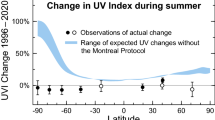Abstract
Surface ultraviolet (UV) radiation plays an important role in human health. Increased exposure to UV radiation increases the risk of skin cancer. In Australia, public campaigns to prevent skin cancer include the promotion of daily UV forecasts. If all other atmospheric factors are equal, stratospheric ozone decreases result in UV increases. Given that Australia still has the highest skin cancer rates in the world, it is important to monitor Australia’s stratospheric ozone and UV radiation levels over time because of the effects cumulative exposure can have on humans. In this paper, two long-term ozone datasets derived from surface and satellite measurements, a radiation code and atmospheric meteorological fields are used to calculate clear-sky UV radiation over a 50-year period (1959–2009) for Australia. The deviations from 1970–1980 levels show that clear-sky UV is on the rise. After the 1990s, an overall annual increase from 2 to 6% above the 1970–1980 levels was observed at all latitudes. Examining the summer and winter deviations from 1970–1980 showed that the winter signal dominated the annual changes, with winter increases almost twice those in summer. With ozone levels not expected to recover to pre-depletion levels until the middle of this century, UV levels are expected to continue to rise. Combined with Australians favoring an outdoor life-style, when temperatures are warmer, under high levels of UV, the associated risk of skin cancer will increase.






Similar content being viewed by others
References
Andrady AL, Aucamp PJ, Austin A, Bais AF, Ballaré CL, Björn LO, Bornman JF, Caldwell MM, Cullen AP, de Gruijl FR, Erickson DJ, Flint SD, Häder D-P, Hamid HS, Ilyas M, Longstreth J, Lucas RM, Madronich S, McKenzie RL, Norval M, Paul ND, Robinson R, Shao M, Solomon KR, Sulzberger B, Takizawa Y, Tang X, Torikai A, van der Leun JC, Williamson CE, Wilson SR, Worrest RC, Zepp RG (2011) Environmental effects of ozone depletion and its interactions with climate change: 2010 assessment. Executive summary. Photochem Photobiol Sci 10:178–181
Armstrong BK (2004) How sun exposure causes skin cancer: an epidemiological perspective. In: Hill D, Elwood JM, English DR (eds) Prevention of skin cancer, cancer prevention - cancer causes, vol 3. Kluwer, The Netherlands, pp 89–116
Australian Institute of Health and Welfare (AIHW) (2008) Non-melanoma skin cancer: general practice consultations, hospitalisation and mortality, Cancer series no. 43. Cat no. 39. Australian Institute of Health and Welfare, Canberra, Australia
Australian Institute of Health and Welfare Australasian Association of Cancer Registries (AIHW/AACR) (2007) Australian cancer incidence and mortality workbooks (ACIM). Australian Institute of Health and Welfare. Retrieved from www.aihw.gov.au/cancer/data/acim_books/index.cfm on February 8, 2010.
Bourke W, Hart T, Steinle P, Seaman R, Embery G, Naugton M, Rikus L (1995) Evolution of the Bureau of Meteorology global assimilation and prediction system. Part 1: Analysis and Initialisation. Aust Meteorol Mag 44:19–40
Commision Internationale d'Eclairage (CIE) (1987) A reference action spectrum for ultraviolet induced erythema in human skin. CIE J 6:17–22
Dobbinson SJ, Wakefield M, Hill D, Girgis A, Aitken JF, Beckmann K, Reeder AI, Herd N, Fairthorne A, Bowles KA (2008) Prevalence and determinants of Australian adolescents' and adults' weekend sun protection and sunburn, summer 2003–2004. J Am Acad Dermatol 59(4):602–614
Gleason JF, Bhartia PK, Herman JR, McPeters R, Newman P, Stolarski RS, Flynn L, Labow G, Larko D, Seftor C, Wellemeyer C, Komhyr WD, Miller AJ, Planet W (1993) Record low global ozone in 1992. Science 260:523–526
Intergovernmental Panel on Climate Change (IPCC) (2007a) Fourth Assessment Report: Climate Change (2007): Synthesis Report: Projected climate change and its impacts. http://www.ipcc.ch/publications_and_data/ar4/syr/en/spms3.html
Intergovernmental Panel on Climate Change (IPCC) (2007b) Technical Summary. In: Solomon S (ed) Climate Change 2007: The Physical Science Basis: Contribution of Working Group I to the Fourth Assessment Report of the Intergovernmental Panel on Climate Change. Cambridge University Press, United Kingdom and New York
Lemus-Deschamps LL, Rikus L, Gies P (1999) The operational Australian ultraviolet index forecast 1997. Meteorol Appl 6:241–251
Lemus-Deschamps LL, Rikus L, Grainger S, Gies P, Sisson J, Li Z (2004) UV Index and UV dose distributions for Australia (1997–2001). Aust Meteorol Mag 53:239–250
National Cancer Control Initiative (NCCI) 2003. The 2002 national non-melanoma skin cancer survey, A report by the NCCI Non-melanoma Skin Cancer Working Group. Edited by MP Staples. NCCI Melbourne. www.ncci.org.au
Queensland Cancer Registry (TCCQ) (2008). Cancer in Queensland incidence and mortality 1982 to 2005 statistical tables. The State of Queensland, Queensland Health: Brisbane, January 2008. Available from http://www.health.qld.gov.au/hic/qcr2005/1982_2005.pdf.
Uppala SM, Kållberg PW, Simmons AJ, Andrae U, da Costa BV, Fiorino M, Gibson JK, Haseler J, Hernandez A, Kelly GA, Li X, Onogi K, Saarinen S, Sokka N, Allan RP, Andersson E, Arpe K, Balmaseda MA, Beljaars ACM, van de Berg L, Bidlot J, Bormann N, Caires S, Chevallier F, Dethof A, Dragosavac M, Fisher M, Fuentes M, Hagemann S, Hólm E, Hoskins BJ, Isaksen L, Janssen PAEM, Jenne R, McNally AP, Mahfouf J-F, Morcrette J-J, Rayner NA, Saunders RW, Simon P, Sterl A, Trenberth KE, Untch A, Vasiljevic D, Viterbo P, Woollen J (2005) The ERA-40 re-analysis. Q J R Meteorol Soc 131:2961–3012
Victorian Cancer Registry (VCR) (2009). Cancer trends, Victoria. Cancer Council Victoria: Melbourne. Available from http://vcrdata.cancervic.org.au:8082/ccv/#.
Vishvakarman D, Wong JC, Boreham BW (2001) Annual occupational exposure to ultraviolet radiation in central Queensland. Health Phys 81(5):536–544
World Health Organization (WHO) (2002). Global Solar UV Index: A practical guide: A joint recommendation of the World Health Organization, World Meteorological Organization (WMO), United Nations Environment Programme, and the International Commission on non-ionizing radiation protection. WHO: Geneva, Switzerland, Available from http://www.who.int/uv/publications/en/UVIGuide.pdf
World Meteorological Organization (WMO) (2006): Global Ozone Research and Monitoring Project-Report No 50: Scientific Assessment of Ozone Depletion: 2006
Author information
Authors and Affiliations
Corresponding author
Rights and permissions
About this article
Cite this article
Lemus-Deschamps, L., Makin, J.K. Fifty years of changes in UV Index and implications for skin cancer in Australia. Int J Biometeorol 56, 727–735 (2012). https://doi.org/10.1007/s00484-011-0474-x
Received:
Revised:
Accepted:
Published:
Issue Date:
DOI: https://doi.org/10.1007/s00484-011-0474-x




